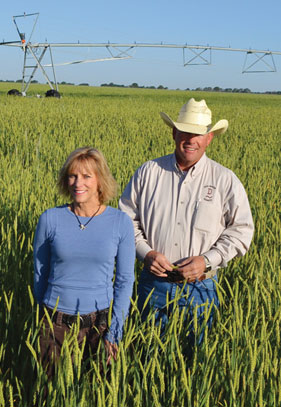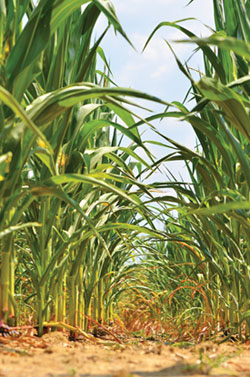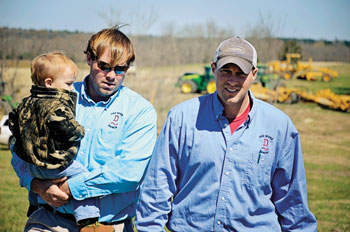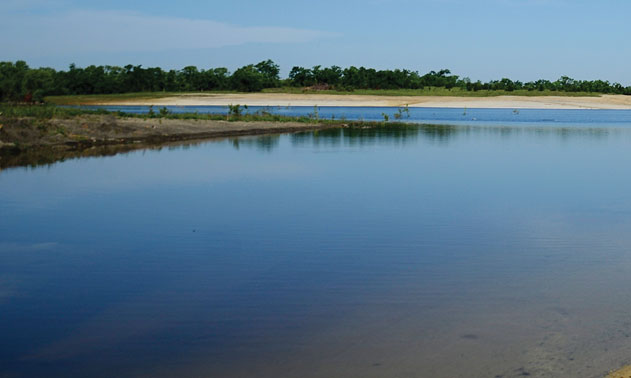You could say water is the whole reason the Dee family is in Alabama.
In the late 1980s, the owners of Dee River Ranch were ready to sell 8,000 acres north of Tampa to the State of Florida under a program to conserve land near waterways and wetlands. But after a two-year search from the Carolinas to Texas, they hadn’t found property suitable for starting over.
Then Roy Dee’s college roommate, Pep Johnston, called to make a friendly wager on the Alabama–Notre Dame football game. The Pickens County, Ala., district attorney also mentioned that land that had once belonged to famed Alabama meat producer R.L. Zeigler soon would be coming up for auction.

Siblings Annie and Mike Dee manage the 10,000-acre Dee River Ranch near Aliceville, Ala., where they raise cattle and grow wheat, rye, soybeans, corn and cotton. Six consecutive dry years inspired them to create an irrigation system that will supply 13 center pivots with runoff collected in their new 110-acre reservoir.
Photo by Ashley Layson
The property never made it to the auction block. With 10,000 acres — including one 2,000-acre field that straddles Alabama and Mississippi — it was about the right size for the Dees, and it received 56 inches of rain in an average year. In 1989 Roy and his wife, Mary Ann, and their family made the move, bringing along the ranch’s name, equipment, horses and cattle.
Dee River Ranch is now managed by two of their 12 children, Annie and Mike Dee. Annie’s twin sons, Seth and Jesse More, and niece, Amber Wilkinson, handle most of the planting, spraying and hay baling, as well as the cattle and horses.
But at first there was a steep learning curve going from Florida sugar sand to the mixed soil types and terrain west of Aliceville, where a rain can stop work for days and get cattle and equipment caught in the mire, Annie says.
They adapted by identifying the best uses of the land. About 4,000 rolling acres are devoted to cattle, and 4,000 acres of flatter, heavier ground to crops. The Dees manage about 2,000 acres of the most erodible land for wildlife.
Water When You Need It
One feature the property didn’t have was irrigation, so the Dees built up the organic matter in the soil, their best way to increase its water-holding capacity and make nutrients available to plants. Their extensive use of cover crops, no-till farming, rotational grazing and other practices that improve soil and water quality and reduce erosion have won them recognition for their stewardship.
“Sustainability is such a key word these days, but that’s how we’ve lived,” Mike Dee says. “We have to keep improving the soil. It’s our bank. It’s our factory. It’s the key to our whole operation. We have to utilize it to its potential.”
But even the best soil and practices need water to be successful. That lesson hit home when the rain stopped falling about six years ago.
Annie says she’ll never forget a visit from University of Alabama–Huntsville climatologist John Christy and atmospheric scientist Dick McNider in May 2006.
“We had the best crop potential we’d ever had. Everything looked beautiful,” Annie says. “We got right to the gate of the 2,000-acre field, and one of them said, ‘What happens if it doesn’t rain again?’”

Droughts have caused leaf curl on the corn and shrinking yields on several crops since 2006. The Dees responded by collecting rainwater when there is a winter surplus and irrigating during the growing season. Their first irrigated acres increased yields up to sevenfold last year.
Photo by Jodie More/Hayden More Photography
They didn’t know it at the time, but they’d seen the end of the rain for that season and the start of a vicious dry period. In the years since, precipitation has dropped by as much as half, and so have the Dees’ corn, soybean and wheat yields.
Saving for a Dry Day
They had explored irrigation in the past, but now their need was urgent.
In Alabama’s Black Belt, where some groundwater is so salty that it’s used to raise shrimp, the solution would have to be surface water. Their irrigation mentor, northern Alabama farmer Dennis Bragg, suggested that they collect water from their land when they have a surplus.
“We get most of our rainfall in the winter. We can’t utilize it, and it’s actually a hindrance at times,” says Mike, who has headed up their irrigation project. “The key is storing it for a time when we can really use it in our growing cycle.”
The Dees started small last year, irrigating 424 acres with rainwater runoff collected in a new 25-acre reservoir and in an existing cow pond.
They were astonished at the difference in yields. Irrigated areas produced up to seven times as much corn and up to 2½ times as many soybeans.
“We decided to hurry up and build a bigger reservoir,” Annie says.
From Pondering to Pond
Applying their philosophy of putting land to the best use, the family decided to dam one end of a brush-filled gully high on the property, allowing gravity to help deliver water down to their fields.
Working out the details took months. The Dees collaborated with local engineer Steve Miller, Zimmatic dealer Rodney Mast, and Randy Wood of Nebraska irrigation company Lindsay Corp., which sent experts from Oregon and Wisconsin to mull the situation.
“That was the most exhausting part,” Annie says. “Every little change made a whole new set of scenarios.”
But they arrived at a solution, creating a 110-acre reservoir an average of 17 feet deep, or 50 feet at the deepest point. Water is supplied by runoff from about 500 acres of pasture, and is held back by a berm more than four stories tall and almost half a mile long.
Ultimately, the reservoir will irrigate 2,650 acres — the 2,000-acre field and eight smaller fields — using 13 center pivots, seven of which are already in place.
Efficient Technology

Annie’s sons, Jesse and Seth More, celebrate the completion of the 110-acre reservoir at a picnic sponsored by Alabama Ag Credit this spring. Both worked on the earth-moving crew that built the lake with the equipment behind them. Jesse is holding his nephew, Mason.
Photo by Jodie More/Hayden More Photography
The Dees wanted to make sure they could maximize their return with an efficient, long-lasting system. Electric vertical turbine pumps move the water through 30-inch underground pipes, which have a projected lifespan of up to 50 years or more. GPS receivers track the pivots’ positions in the fields, and an automated program applies water and nutrients in a pattern customized for the variable soils. Sensors monitor soil moisture and temperature, indicating the best times to plant and irrigate.
Technology extends to every corner of the ranch: The family can control the system from a smartphone or computer anywhere on the property, thanks to a new wireless broadband network. Providing power are miles of new electrical lines the Dees hired Alabama Power to install.
“Something this big makes the farmers talk,” says Ed Boyd, regional president at Alabama Ag Credit’s branch office in Monroeville. “Word is getting around about the irrigation project in Pickens County. It looks like the rural water department has moved all its pipe down there.”
Boyd first met the Dees last year when they worked with the lending cooperative to finance part of the project. Annie says she appreciated Alabama Ag Credit’s thoroughness and grasp of irrigation. But at Dee River Ranch, which is as self-sustaining as it is sustainable, it’s an unusual step to get financing at all.
“As Annie will tell you, she doesn’t like debt,” says Chris Higbe, vice president of credit at the administrative office in Montgomery. “But they saw that financing a portion of this project was the best option for them.”
Mike says that putting in the system piecemeal might have been cheaper initially, but they were looking for the highest possible returns.
“The infrastructure is right at the beginning, and we’ve got to recoup that cost, but the savings is in the efficiency of these electric motors and having one integrated system,” he says.
“With the difference in yields last year, our first irrigation project would have paid for itself within three full crops,” Annie says. “We’ve given ourselves a little cushion and plan to pay the bigger system off in seven to 10 years.”
In a way, it’s as though the Dees have come full circle.
“What got us here was water, and here we are collecting our own,” Annie says.
– Staff
Awards and Outreach
Siblings Annie and Mike Dee are committed to finding the best practices for their row crop and cattle operation, and to sharing their discoveries.
“Mike and I are really involved in agriculture groups in the corn, soybean and cattle industries,” says Annie, who was appointed to the United Soybean Board by U.S. Agriculture Secretary Tom Vilsack last year. Mike was president of the Alabama Cattlemen’s Association in 2010.
“These groups keep telling us that if we want the public to know what ag producers are doing, we’ve got to tell our own story,” she says.
Among the ways they do that is through their website, blog and Facebook page, the work of Annie’s daughter-in-law, Jodie More. DeeRiverRanch.com is a good first stop for virtual visitors, whether they want to buy an experienced Florida cracker horse or learn about the ranch’s accomplishments.
Sustainable practices have won the ranch numerous accolades in the past five years, including the USDA’s national Excellence in Conservation Award, a regional award in the Environmental Stewardship Award Program, and the Alabama Governor’s Conservation Achievement Award for Soil Conservationist of the Year. This spring, Mike, Annie and her son Jesse More picked up three state awards in the 2011 National Corn Yield Contest.
On the education front, the Dees host farm visits for students, from third-graders to college students who plan to become rural doctors.
“It’s kind of become my passion,” Annie says of their work for Alabama’s Rural Medical Scholars Program. “They’re the ones who are going to be taking care of us.”
The ranch is a laboratory for the most current practices and products. At Auburn University, where Annie’s husband, Ed Sikora, is a professor and extension plant pathologist, the Dees have worked with several departments, the Natural Resources Management and Development Institute, and the USDA National Soil Dynamics Laboratory. They have collaborated with Cooperative Extension at both Auburn and at nearby Mississippi State University, and with state and federal agencies such as the USDA Soil Climate Analysis Network, which has a weather station on the farm. Through their partnerships, they have researched plant varieties and chemicals, studied geospatial technology, produced their own biodiesel, and more.
Their newest partners are Lindsay Corp. and its subsidiaries, which installed and will monitor the state-of-the-art irrigation and wireless communications systems, which were unveiled at a technology field day in May attended by officials, neighbors and farmers from three states.

Watch a segment about the Dee family from a 2012 episode of the public television series “America’s Heartland.”
